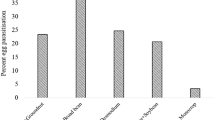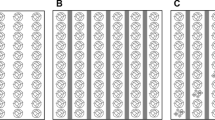Abstract
Field trials in Kenya demonstrated that the forage grass, Sorghum vulgare sudanense (Sudan grass) attracted greater oviposition by stemborers than cultivated maize, resulting in significant increase in maize yield. On the other hand, the non-host forage plant, Melinis minutiflora (molasses grass), when inter-cropped with maize, repelled gravid stemborer females from ovipositing on maize, resulting in significant reduction in stemborer infestation. Using these trap- and repellent gramineous plants, a novel pest management approach based on a ’push-pull’ or stimulo-deterrent diversionary strategy is being developed where stemborers are repelled from the food crop and are simultaneously attracted to a discard or trap crop. The plant composition and permanence of habitat surrounding maize fields also influence the abundance of natural enemies that invade agroecosy stems once a pest population is present. It may be advantageous to promote the growth of native Gramineae and other wild plants which minimise, or even suppress, population growth of pests during non-cropping seasons, but still provide a suitable habitat for natural enemies.
Résumé
Des essais de terrain au Kenya ont prouvé que l’herbe fourragère, Sorghum vulgare sudanense (herbe du Soudan) attirait plus de foreurs de tiges pour la ponte que le maïs cultivé, entraînant une augmentation significative de la récolte de maïs. D’autre part, la plante fourragère non-hôte, Melinis minutiflora (herbe mélasse), une fois en culture mixte avec le maïs, empêchait des foreurs de tiges femelles gravides de pondre sur le maïs, ce qui réduisait significativement l’infestation du maïs par les foreurs de tiges. L’utilisation de ces plantes graminées pièges et répulsives, une approche nouvelle du contrôle des ravageurs basée sur une strategie diversionniste de ’pousse-tire’ ou de ’stimulation-déterrence’ est en train d’être dévelopée là où les foreurs de tiges sont repoussés loin des cultures de consommation et sont simultanément attirés vers une plante rebut ou piège. La composition botanique et la permanence de l’habitat entourant les champs de maïs influencent aussi l’abondance des ennemis naturels qui envahissent des agroécosystèmes dès qu’une population de ravageurs est présente. Il serait avantageux de promouvoir la croissance des graminées indigènes et d’autres plantes sauvages qui minimisent ou même inhibent la croissance des populations des ravageurs durant les saisons de jachère, tout en assurant un habitat favorable pour les ennemis naturels.
Similar content being viewed by others
References
Altieri M. A. (1981) Weeds may augment biological control of insects. Calif. Agric. 35, 22–24.
Altieri M. A. (1991) Increasing biodiversity to improve insect pest management in agro-ecosystems, pp. 157–162. In Biodiversity of Microorganisms and Invertebrates: Its Role in Sustainable Agriculture (Edited by D. L. Hawksworth). Proceedings of the First Workshop on the Ecological Foundations of Sustainable Agriculture, London, U. K., 26–27 July 1990. CAB International, Wallingford, UK.
Altieri M. A. and Letourneau D. K. (1984) Vegetation diversity and outbreaks of insect pests. CRC Crit. Rev. Plant Sci. 2, 131–169.
Altieri M. A. and Whitcomb W. H. (1979) The potential use of weeds in the manipulation of beneficial insects. Hort Sience 14, 12–18.
Altieri M. A., van Schoonhoven A. and Doll J. (1977) The ecological role of weeds in insect pest management systems: A review illustrated with bean (Phaseolus vulgaris L.) cropping system. PANS 24, 185–206.
Ampofo J. K. O. (1986) Maize stalk borer (Lepidoptera: Pyralidae) damage and plant resistance. Environ. Entomol. 15, 1124–1129.
Boonman J. G. (1992) Tropical grasses from the East African Centre of Biodiversity. Biotechnology and Development Monitor 11, 9–10.
Bowden J. (1976) Stem borer ecology and strategy for control. Ann. Appl. Biol. 84, 107–111.
Dennis P. and Fry G. L. A. (1992) Field margins: Can they enhance natural enemy population densities and general arthropod diversity on farmland? Agric. Ecosyst. Environ. 40, 1–4. 95–115.
Harris K. M. (1990) Bioecology of Chilo species. Insect Sci. Applic. 11, 467–477.
Herzog D. C. and Funderburk J. E. (1986) Ecological bases for habitat management and pest cultural control, pp. 217–250. In Ecological Theory and Integrated Pest Management Practice (Edited by M. Kogan). John Wiley & Sons.
Hutter N. J. (1996) An assessment of the potential value of ten varieties of Napier grass (Pennisetum purpureum) with respect to their use as a trap crop for the spotted stem borer (Chilo partellus) attacking maize (Zea mays). MSc Thesis in Tropical Agriculture and Environmental Science, Department of Agricultural and Environmental Science, University of NewCastle-upon-Tyne, Newcastle, UK.
Ibrahim K. M. and Kabuye C. H. S. (1987) An Illustrated Manual of Kenya Grasses. FAO, Rome. 765 pp.
Ingram W. R. (1958) The lepidopterous stalk borers associated with Graminae in Uganda. Bull. Entomol. Res. 49, 367–383.
Joyce R. J. V. (1976) Insect flight in relation to problems of pest control, pp. 135–155. In Insect Flight (Edited by R. C. Rainey). Blackwell, Oxford.
Khan Z. R., Ampong-Nyarko K., Chiliswa P., Hassanali A., Kimani S., Lwande W., Overholt W. A., Pickett J. A., Smart L. E., Wadhams L. J. and Woodcock C. M. (1997) Intercropping increases parasitism of pests. Nature (London) 388, 631–632.
Mally C. W. (1920) The maize stalk borer: Busseola fusca Fuller. Department of Agriculture, Union of South Africa, Bulletin no. 3. Cape Times Limited, Government Printers. 111 pp.
Mwangi E. N.; Essuman S.; Kaaya G. P.; Nyandat E.; Munyinyi D. and Kimondo M. G. (1995) Repellency of the tick Rhipicephalus appendiculatus by the grass Melinis minutiflora. Trop. Anim. Hlth Prod. 27, 211–216.
Powell W. (1986) Enhancing parasite activity in crops, pp. 319–340. In Insect Parasitoids (Edited by J. Waage and D. Greathead). Academic Press, London.
Price P. W. (1976) Colonization of crops by arthropods: nonequilibrium communities in soybean fields. Environ. Entomol. 5, 824–835.
Schulthess F., Bosque-Perez N. A., Chabi-Olaye A., Gounou S., Ndemah R. and Goergen G. (1997) Exchange of natural enemies of lepidopteran cereal stemborers between African regions. Insect Sci. Applic. 17, 97–108.(this issue).
Seshu Reddy K. V. (1983) Studies on the stem borer complex of sorghum in Kenya. Insect Sci. Applic. 4, 3–10.
Seshu Reddy K. V. and Sum K. O. S. (1992) Yield-infestation relationship and determination of economic injury level of the stem borer, Chilo partellus (Swinhoe) in three varieties of maize, Zea mays L. Maydica 37, 371–376.
Smart L. E., Stevenson J. H. and Walters J. H. H. (1989) Development of field trial methodology to assess short-term effects of pesticides on beneficial arthropods in arable crops. Crop Protection 8, 169–180.
Thompson K. C., Roa E. and Romero N. (1978) Anti-tick grasses as the basis for developing practical tropical tick control packages. Trop. Anim. Hlth Prod. 10, 179–182.
Usua E. J. (1968) The biology of Busseola fusca and Sesamia species in south-western Nigeria: Distribution and population studies. J. Econ. Entomol. 61, 830–833.
van Emden H. F. and Way M. J. (1971) Host plants in the population dynamics of insects, pp. 181–199. In Insect/Plant Relationships (Edited by H. F. van Emden). Blackwell, Oxford.
van Emden H. F. and Dabrowski Z. T. (1994) Biodiversity and habitat modification in pest management. Insect Sci. Applic. 15, 605–620.
Waage J. (1991) Biological control and biodiversity. Biology Education 8, 63–70.
Watt A. D. (1981) Wild grasses and grain aphid (Sitobion avenae), pp. 222–229. In Pests, Pathogens, and Vegetation (Edited by J. M. Tresh). Pitman, London.
Author information
Authors and Affiliations
Rights and permissions
About this article
Cite this article
Khan, Z.R., Chiliswa, P., Ampong-Nyarko, K. et al. Utilisation of Wild Gramineous Plants for Management of Cereal Stemborers in Africa. Int J Trop Insect Sci 17, 143–150 (1997). https://doi.org/10.1017/S1742758400022268
Accepted:
Published:
Issue Date:
DOI: https://doi.org/10.1017/S1742758400022268




